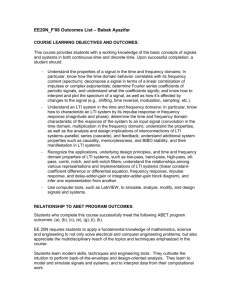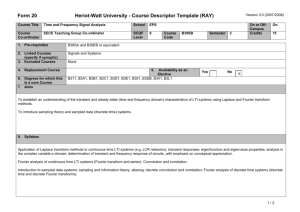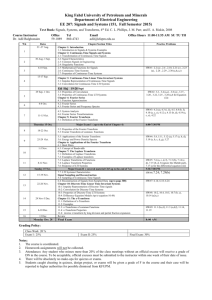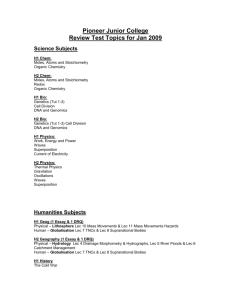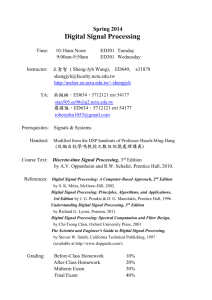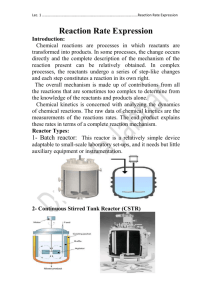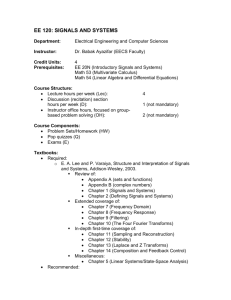Word - Electrical Engineering & Computer Sciences
advertisement
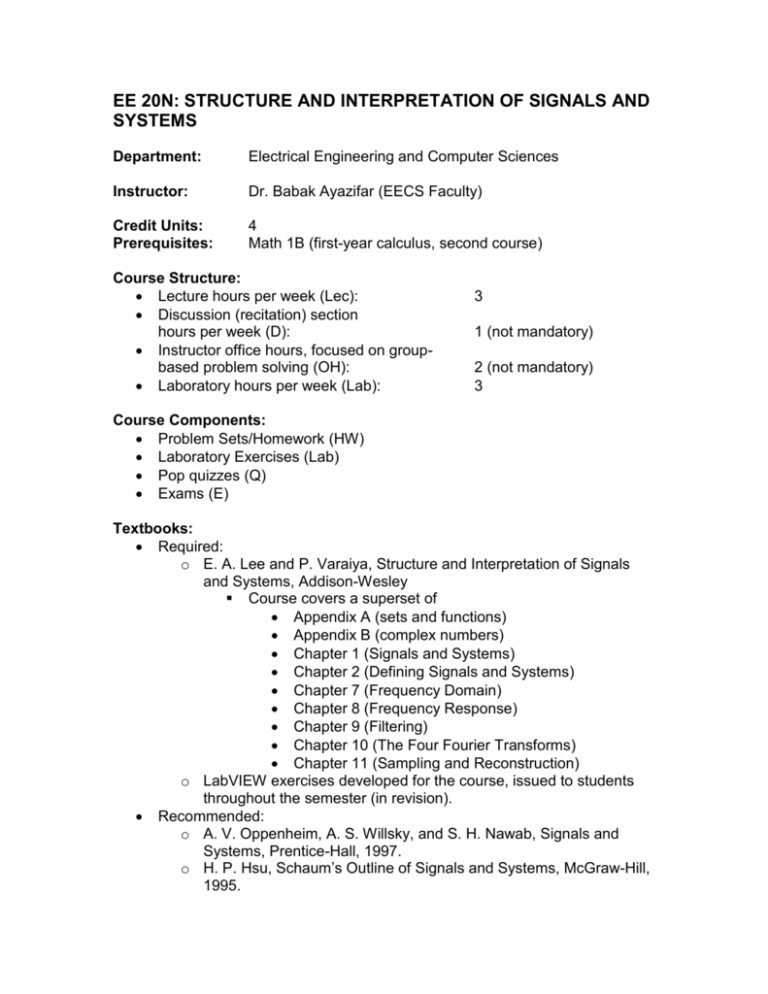
EE 20N: STRUCTURE AND INTERPRETATION OF SIGNALS AND SYSTEMS Department: Electrical Engineering and Computer Sciences Instructor: Dr. Babak Ayazifar (EECS Faculty) Credit Units: Prerequisites: 4 Math 1B (first-year calculus, second course) Course Structure: Lecture hours per week (Lec): Discussion (recitation) section hours per week (D): Instructor office hours, focused on groupbased problem solving (OH): Laboratory hours per week (Lab): 3 1 (not mandatory) 2 (not mandatory) 3 Course Components: Problem Sets/Homework (HW) Laboratory Exercises (Lab) Pop quizzes (Q) Exams (E) Textbooks: Required: o E. A. Lee and P. Varaiya, Structure and Interpretation of Signals and Systems, Addison-Wesley Course covers a superset of Appendix A (sets and functions) Appendix B (complex numbers) Chapter 1 (Signals and Systems) Chapter 2 (Defining Signals and Systems) Chapter 7 (Frequency Domain) Chapter 8 (Frequency Response) Chapter 9 (Filtering) Chapter 10 (The Four Fourier Transforms) Chapter 11 (Sampling and Reconstruction) o LabVIEW exercises developed for the course, issued to students throughout the semester (in revision). Recommended: o A. V. Oppenheim, A. S. Willsky, and S. H. Nawab, Signals and Systems, Prentice-Hall, 1997. o H. P. Hsu, Schaum’s Outline of Signals and Systems, McGraw-Hill, 1995. RELATIONSHIP TO ABET PROGRAM OUTCOMES: Students who complete this course successfully meet the following ABET program outcomes: (a), (b), (c), (e), (g), (i), (k). EE 20N requires students to apply a fundamental knowledge of mathematics, science and engineering to not only solve electrical and computer engineering problems, but also appreciate the multidisciplinary reach of the topics and techniques emphasized in the course. Students learn modern skills, techniques and engineering tools. They cultivate the intuition to perform back-of-the-envelope and design-oriented analysis. They learn to model and simulate signals and systems, and to interpret data from their computational work. Problem sets and exams are designed to probe a thorough understanding of fundamental concepts and to de-emphasize rote algebraic manipulation. Exam problems insist on refined and to-the-point responses; limited space is allocated for each problem to encourage students to think more clearly and logically, and to articulate their responses efficiently and without clutter. The various components of the course encourage students to think graphically and draw, before they reach for mathematical formulae. Lectures, discussion sections, labs, and instructor’s office hours promote group work by engaging the students in a collaborative learning environment where they divide into groups of 3-5 students and discuss the solutions to the various problems posed to them. In discussion sections and office hours, students are asked to present their solutions to their peers on the board, to guide discussion among their peers by asking each other questions and assisting each other toward solutions. Recognizing that team work is an integral part of engineering practice, the homework policy encourages collaborative groups of up to five students. COURSE LEARNING OBJECTIVES AND OUTCOMES: This course provides students with a working knowledge of the basic concepts of signals and systems in both continuous-time and discrete-time. Upon successful completion, a student should: Know the essentials of sets and set operations—in particular, the properties of the sets of real numbers, integers, and complex numbers. Coverage: Lec, D, HW, Q, E, OH, Lab (for complex numbers) Student Success: Excellent Know the essentials of symbolic logic, and be able to carry out basic proof methods, such as “proof by contradiction,” “proof by counter-example,” “proof by induction,” etc. Coverage: Lec, D, HW, Q, E, OH Student Success: Fair Know the algebra of complex numbers and functions, including their Cartesian and polar representations, and their magnitudes and phases. Coverage: Lec, D, HW, Q, E, OH, Lab Student Success: Excellent Recognize that signals and systems are functions that map elements in a respective domain to elements in a corresponding co-domain. Coverage: Lec, D, HW, Q, E, OH Student Success: Excellent Recognize the various categories of signals (continuous-time, discretetime, analog, and digital) as well as systems, based on the nature of the domains and co-domains that characterize their functional representations. Coverage: Lec, D, HW, Q, E, OH, Lab Student Success: Excellent Graph mathematical descriptions of discrete-time and continuous-time signals (including magnitude and phase plots of complex-valued functions), and write mathematical descriptions of graphed functions. Coverage: Lec, D, HW, Q, E, OH, Lab Student Success: Excellent Classify systems based on their properties: in particular, understand and exploit the implications of linearity, time-invariance, causality, and memory. Coverage: Lec, D, HW, Q, E, OH Student Success: Very Good Understand the combined implications of linearity and time invariance in the time domain—the time-domain properties of linear, time-invariant (LTI) systems. In particular, o represent an LTI system by an impulse response; and o determine the response of the LTI system to an arbitrary input signal using convolution. Coverage: Lec, D, HW, Q, E, OH, Lab Student Success: Very Good Understand the combined implications of linearity and time invariance in the frequency domain—the frequency-domain properties of linear, timeinvariant (LTI) systems. In particular, o represent the response of an LTI system to a complex exponential and understand that complex exponentials are eigenfunctions of LTI systems; o represent an LTI systems by its frequency response function (magnitude and phase). o determine the input-output behavior of an LTI system entirely in the frequency domain. Coverage: Lec, D, HW, Q, E, OH, Lab Student Success: Excellent Understand an LTI system’s frequency response in terms of both magnitude and phase, and recognize design principles behind basic filters such as low-pass, band-pass, high-pass, comb, notch, and anti-notch. Coverage: Lec, D, HW, Q, E, OH, Lab Student Success: Very Good Know how to decompose a signal in terms of a linear combination of impulses in the time domain. Coverage: Lec, D, HW, Q, E, OH Student Success: Excellent Know how to decompose a signal in terms of complex exponentials in the frequency domain: o Periodic Signals: determine Fourier series coefficients for both discrete-time and continuous-time periodic signals, and understand the implications of what the coefficients mean; o Aperiodic Signals: determine Fourier transforms for both continuous-time and discrete-time signals (or impulse-response functions), and understand how to interpret and plot Fourier transform magnitude and phase responses. o Understand the impulsive nature of the Fourier transforms of periodic signals. Coverage: Lec, D, HW, Q, E, OH, Lab Student Success: Very Good Understand the various properties of transforms—including time-shift, modulation (frequency shift), duality, symmetry and anti-symmetry—and exploit them to analyze and design signals and systems. Coverage: Lec, D, HW, Q, E, OH Student Success: Good Understand the relationships among various representations of LTI systems—linear constant-coefficient difference or differential equation, frequency response, and impulse response—and to infer one representation from another (e.g., determine the impulse response from the difference equation, etc.) Coverage: Lec, D, HW, Q, E, OH Student Success: Very Good Understand the properties, as well the analysis and design implications, of interconnections of LTI systems—parallel, series (cascade), and feedback—in the time and frequency domains. Coverage: Lec, D, HW, Q, E, OH, Lab Student Success: Excellent Understand the sampling theorem, how to derive it from first principles and basic properties of the continuous-time Fourier transform, and how to use to understand aliasing phenomena in the real-world (e.g., the carriage wheel effect). Coverage: Lec, D, HW, Q, E, OH, Lab Student Success: Fair Use computer tools, such as LabVIEW, to simulate, analyze, and design discrete-time and continuous-time signals and systems. Coverage: Lab Student Success: Very Good TOPICS COVERED: Mathematical Foundations – Sets and functions; Fundamentals of mathematical logic; Complex algebra (including complex-valued functions); Basic linear algebra (matrix-vector manipulations of 2x2 matrices; Vector-space concepts (e.g., basis, dimension, inner products, orthogonal basis expansions). Signals – Signals as functions: continuous time, discrete time; Signals as vectors in an appropriately-defined vector space having an appropriatelydefined inner product; Orthogonality of signals; Two-dimensional space continuum; Discrete-space: discrete time and continuous space, discrete time and mixed space, discrete time and space, discrete events, discrete events and discrete time; Sequences. Sinusoids – Periodic signals, sinusoids-phase and amplitude, complex numbers, complex signals, complex exponentials; Phasors, amplitude modulation, frequency modulation. Spectrum – Summing sinusoids, approximating periodic signals, harmonics and musical sounds, beat notes, two-dimensional sinusoids; Approximating images. Sampling – Analog-to-digital conversion, aliasing, downsampling, digitalto-analog conversion, upsampling, oversampling CD players. Systems – Filters, Running average filter, Two-dimensional running average filter, FIR filters; IIR filters; Linearity; Time invariance; Causality; Memory; Impulse response; Convolution. Difference-equation representations of LTI systems. Frequency Response and Filtering – Sinusoidal input, complex sinusoidal input, transfer function; Filtering audio signals, blurring and sharpening images. Fourier Series and Transforms – Fourier series using vector-space concepts; Signals viewed as vectors; Harmonically-related sinusoids and complex exponentials are viewed as orthogonal vectors in an appropriately-defined vector space; Discrete Fourier series (DFS/DFT); Continuous-time Fourier series (FS); Discrete-time Fourier transform (DTFT); Continuous-time Fourier transform (CTFT). Spectrum Analysis – Spectra of periodic and aperiodic signals; Time and frequency sampling; Amplitude modulation; Spectrograms. Interconnections of Systems: Parallel, Cascade, and Feedback; implications of interconnected LTI systems for their time-domain and frequency-domain behaviors. Miscellaneous Topics – Hard limiting; Edge detection; Fractals and chaos; Noise in musical sounds and images. Prepared by: Babak Ayazifar Date: February 2009
